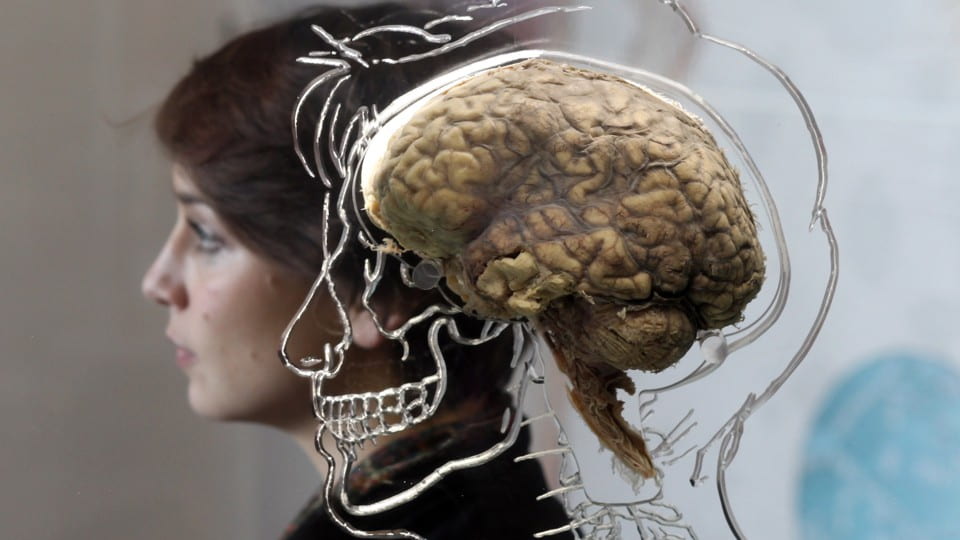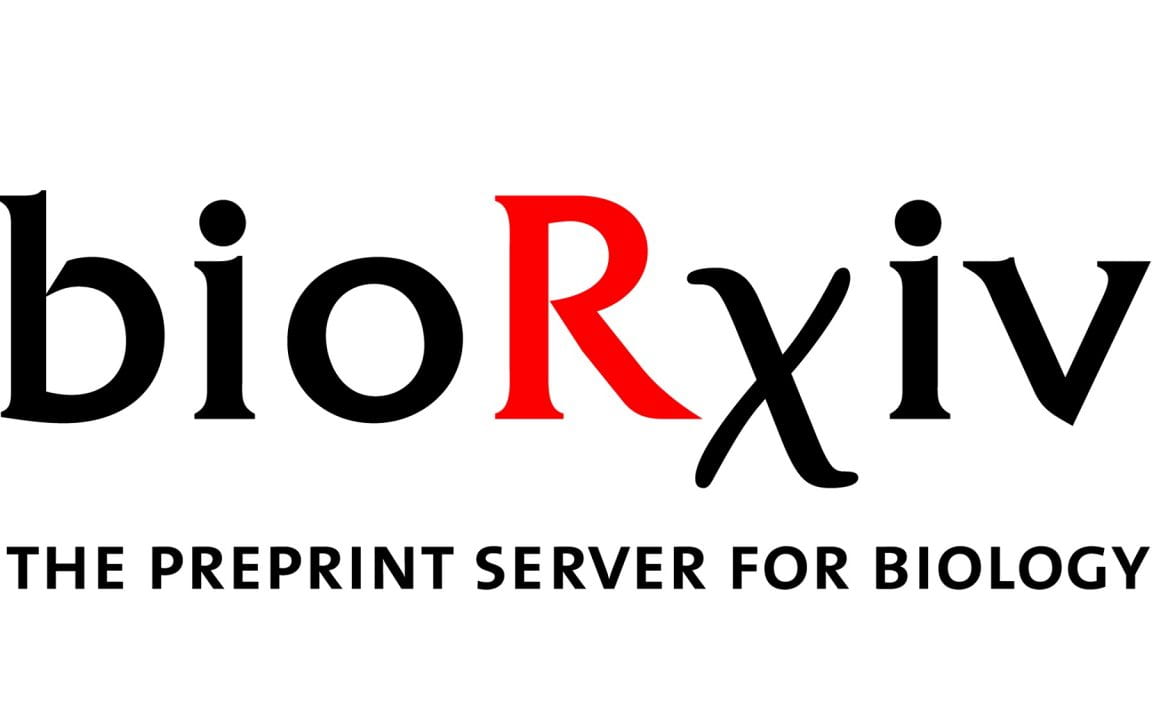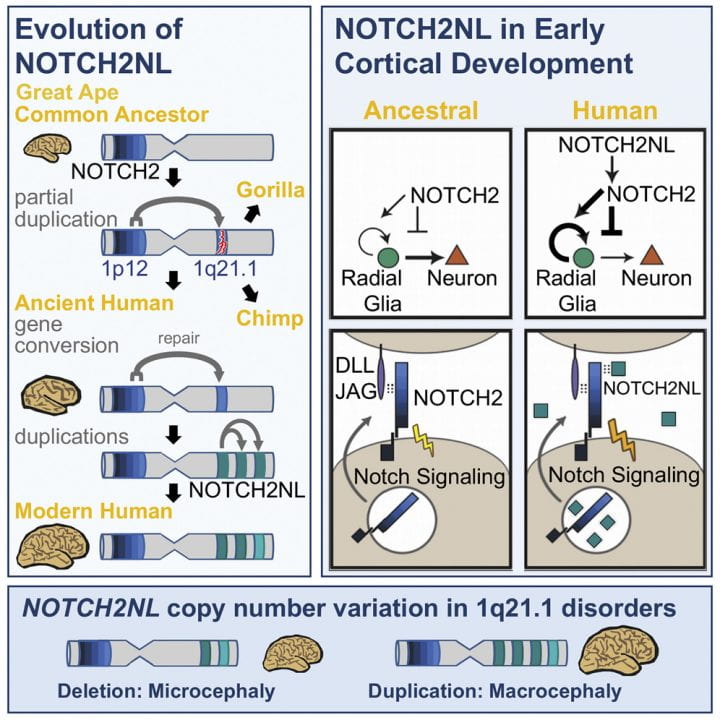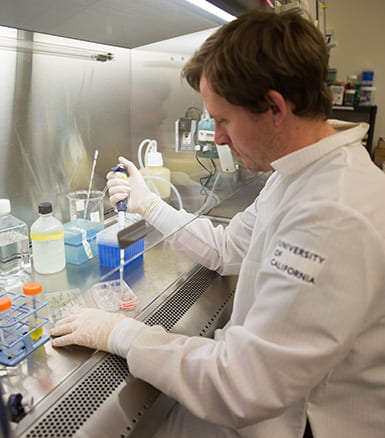Month: May 2018
-

A New Genetic Clue to How Humans Got Such Big Brains
Three genes that appeared during our early evolution probably increased the number of neurons in our heads—but at a cost. ED YONG | The Atlantic 5/31/18 It started with some blobs of brain-like tissue, growing in a dish. Frank Jacobs, then at the University of California at Santa Cruz, had taken stem cells from humans and…
-

Trio of genes supercharged human brain evolution
May. 31, 2018 By Elizabeth Pennisi Three nearly identical genes could help explain how 0.5 liters of gray matter in early human ancestors became the 1.4-liter organ that has made our species so successful and distinctive. The newly identified genes could also help explain how brain development sometimes goes wrong, leading to neurological disorders. The genes,…
-

Scientists Hunt Down Genes Behind Humankind’s Big Brain
By Reuters | May 31, 2018 WASHINGTON — Scientists have pinpointed three genes that may have played a pivotal role in an important milestone in human evolution: the striking increase in brain size that facilitated cognitive advances that helped define what it means to be human. These genes, found only in people, appeared between 3 and 4…
-

Human-specific NOTCH-like genes in a region linked to neurodevelopmental disorders affect cortical neurogenesis
Ian T Fiddes1, Gerrald A Lodewijk2, Meghan M Mooring1, Colleen M Bosworth1, Adam D Ewing1, Gary L Mantalas1, Adam M Novak1, Anouk van den Bout2, Alex Bishara3, Jimi L Rosenkrantz1, Ryan Lorig-Roach1, Andrew R Field1, Maximillian Haeussler1, Lotte Russo2,Aparna Bhaduri4, Tomasz J Nowakowski4, Alex A Pollen4, Max L Dougherty5, Xander Nuttle6, Marie-Claude Addor7, Simon Zwolinski8, Sol Katzman1, Arnold Kreigstein4, Evan E Eichler5, Sofie R Salama1 (ssalama{at}ucsc.edu), Frank MJ Jacobs2 and David Haussler1(haussler{at}ucsc.edu) 1 University of California, Santa Cruz; 2 University of Amsterdam; 3 Stanford University; 4 University of California,…
-

Human-Specific NOTCH2NL Genes Affect Notch Signaling and Cortical Neurogenesis
Ian T. Fiddes1, 15, Gerrald A. Lodewijk2, 15, Meghan Mooring1, Colleen M. Bosworth1, Adam D. Ewing1, 16, Gary L. Mantalas1, 3, Adam M. Novak1, Anouk van den Bout2, Alex Bishara4, Jimi L. Rosenkrantz1, 5, Ryan Lorig-Roach1, Andrew R. Field1, 3, Maximilian Haeussler1, Lotte Russo2, Aparna Bhaduri6, Tomasz J. Nowakowski6, Alex A. Pollen6, Max L. Dougherty7, Xander Nuttle8, 9, 10, Marie-Claude Addor11, Simon Zwolinski12,…
-

A history of big-headedness
The Economist | May 31st 2018 How humans got their brains “HOW the human got his brain” is probably the most important “Just So” story that Rudyard Kipling never wrote. Kipling did not ignore people in his quirky take on evolution. Two of his tales describe the invention of the alphabet and the invention of letter-writing.…
-

Genes found only in humans influence brain size
New genes arose in human ancestors just before a dramatic increase in brain size and are involved in genetic defects associated with neurological disorders May 31, 2018 | By Tim Stephens A set of three nearly identical genes found only in humans appear to play a critical role in the development of our large brains,…
-

Scientists See Promise in Resurrecting These Rhinos That Are Nearly Extinct
May 24, 2018 By Steph Yin Even if the technology can bring back the northern white rhinoceros, should we do it? When the last male northern white rhinoceros died in March, people mourned the beloved mammal’s step toward extinction. With no members of the subspecies left in the wild and just two females remaining in captivity, it…
-

Imminent extinction of northern white rhinoceros motivates genetic recovery efforts
May 24, 2018 By Dana Macciola COLD SPRING HARBOR LABORATORY PRESS Earlier this year, the last remaining male Northern White Rhinoceros (NWR) died in captivity, nearly cementing the fate of this subspecies for extinction. In the wild, continuing threats of poaching, habitat destruction, and small population size have contributed to the rhinos’ status as critically endangered.…
-

HHMI Bets Big On 19 New Investigators
May 23, 2018 By Meghan Rosen Beth Shapiro has dug for prehistoric bones in Siberia. Ralph DeBerardinis has improved the lives of kids with metabolic diseases. Jesse Bloom has uncovered genetic secrets that could help fight the flu. Shapiro, DeBerardinis, and Bloom are among 19 scientists whose work is dramatically advancing our understanding of cells,…
-

DNA ‘Hackathon’ Looks for Cure of Man’s Rare Cancer
May 21, 2018 HELEN CHRISTOPHI SAN FRANCISCO (CN) – Bill Paseman has two choices for treating his rare and deadly kidney cancer: do nothing or let 200 scientists from around the world analyze his DNA to uncover clues for promising new treatments. That’s because there are no effective treatments for his late-stage papillary renal-cell carcinoma…
-

Transfer RNA research addresses a blind spot in understanding of human genes
Biomolecular engineer Todd Lowe has received a $2.7 million grant from the National Institutes of Health to support his lab’s international leadership in transfer RNA research May 17, 2018 By Tim Stephens The human genome includes more than 500 genes for transfer RNA (tRNA) molecules, which are essential for making proteins in all living organisms. Scientists…